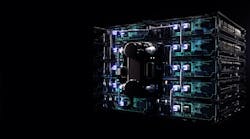Battery technology has evolved over the past several years, helping to bring down costs as well as expand the applications in which electrification can be applied. As batteries for mobile applications are used either in conjunction with a downsized engine as part of a hybrid powertrain or in place of an engine in full-electric architectures, they play an important role in powering a machine and its systems – including the hydraulics and pneumatics.
Although there are solutions which eliminate fluid power systems, in many applications they will remain an important component because “the best operating systems will still require functionality that only fluid power can deliver,” said Brett Engelland, Director of Sales for Electrification, and Nick Moore, Director of Product Management for Electrification, at Vanguard, in an interview with Power & Motion.
Given the growth of electrification in so many vehicle and mobile equipment applications, and the impacts it will have on the design of hydraulics and pneumatics, it is important for those in the fluid power industry to understand where battery technology currently stands.
READ MORE: How is Electrification Impacting Hydraulics and Pneumatics?
Common Battery Types
Lithium-ion batteries are the most commonly used battery type in hybrid and electric vehicles as well as other applications. Their chemistry offers high energy output and efficiency, good high-temperature performance, and a high power-to-weight ratio, among other benefits, all of which is suitable for a range of use cases.
While lithium-ion has its benefits, it also presents challenges. According to research firm IDTechEx, the current versions of lithium-ion may be reaching their performance limits but new developments in cell materials and battery designs could help overcome these.
One possibility is shifting from the currently used graphite anodes to silicon which could provide significant improvements in energy density and performance stated IDTechEx in a press release reviewing findings from its report “Advanced Li-ion and Beyond Lithium Batteries 2022-2032: Technologies, Players, Trends, Markets.” Though it has been difficult to use larger quantities of silicon due to stability and cycle life issues, the research firm said improvements in silicon anode technology over the last 10-15 years is now enabling 5-100% silicon in the anode.
Use of new additives and electrolyte formulations is another way IDTechEx sees improvements to lithium-ion batteries being achieved. It noted one company which is utilizing phosphazenes and phosphorous-nitrogen compounds to help improve safety and performance.
Creation of more space efficient battery packs could also bring performance improvements. IDTechEx said several companies in the automotive space are working on batteries with cell-to-pack designs which eliminate the materials used for module housings; this will lead to a more optimized package as well as improved energy density and battery integration for OEMs. It noted BYD has advertised the potential to improve volume utilization by 50%, from 40% to 60%, and battery manufacturer CATL has announced its latest cell-to-pack design could achieve a 72% volume utilization.
Other commonly used battery chemistries include nickel-metal hydride and lead-acid. According to the U.S. Department of Energy (DOE), nickel-metal hydride batteries provide reasonable specific energy and power capabilities which suits use in computer and medical equipment. They have a longer life cycle than lead-acid, and have been used in hybrid-electric vehicles, but are challenged by their high costs and heat generation at high temperatures. Lead-acid, meanwhile, can offer a high power and inexpensive, safe option but its low specific energy and poor performance in cold temperatures, as well as its short lifespan, reduces its application use.
Research into Alternative Chemistries
As no battery chemistry is perfect, an array of research is taking place into other potential chemistries. For instance, most of the components which make up a lithium-ion battery can be recycled but doing so remains costly to date which is currently a challenge for the industry. Lithium-ion also has a high cost; the battery of an electric vehicle or machine is the most expensive aspect – even as their prices have come down in recent years – challenging the uptake of electric-powered vehicles.
The DOE’s Pacific Northwest National Laboratory is developing a sodium-ion battery which so far has shown promise in large-scale applications. By adjusting the ingredients which make up the battery’s liquid core as well as using a different type of salt, the researchers have shown the potential for a chemistry with extended longevity which could also be a more environmentally friendly option.
Though still in the research and development stage, the battery has demonstrated what other chemistry possibilities could be available in the future.
Researchers at the Tokyo University of Science (TUS) are investigating magnesium as an alternative to lithium ion for solid-state batteries. Among the challenges with the latter is the fact lithium is a rare earth metal – ever increasing demand for batteries will lead to it becoming more scarce; there are also environmental concerns related to the mining of rare earth metals which questions how “green” a battery technology is.
Magnesium, however, is an abundant material but to date its use in practical applications is limited due to the poor conductivity of magnesium ions in solids at room temperature. The researchers at TUS may have overcome this challenge by using metal-organic frameworks (MOFs) which have highly porous crystal structures. This enables efficient migration of the included ions and thus improves the level of conductivity possible.
As explained in a press release from TUS about the research, the team used a MOF known as MIL-101 as the main framework and then encapsulated magnesium ions in its nanopores. In the resultant MOF-based electrolyte, magnesium ions were loosely packed, thereby allowing the migration of divalent magnesium ions. The electrolyte was exposed to acetonitrile vapors, which were adsorbed by the MOF as guest molecules, enabling further enhancement to the material’s conductivity.
Research is ongoing with this material, but testing has shown high levels of conductivity and the potential for this technology to be used in future battery applications.
More Battery Options Increase Use Cases
Although electrification is more commonly associated with passenger vehicles, its implementation in heavy-duty trucking and off-highway equipment – key markets for fluid power, hydraulics in particular – has grown in recent years due in large part to advancements in battery technology. Batteries are now better able to meet the power demands of these larger vehicles while continued reductions in battery prices have helped make them easier to implement.
READ MORE: Construction Equipment Digs Deeper into Electrification
At bauma 2022 and CONEXPO-CON/AGG 2023, it was evident how much electrification of construction equipment has grown in recent years. With that has come new technology partnerships and battery solutions. Danfoss Power Solutions, for instance, announced at bauma its partnership with battery provider Webasto. The companies will bring together their technological expertise in electrification to aid OEMs with the development of electric-powered machines.
Aiding the move to electric power systems in the heavy equipment market are developments of batteries specifically for this segment. Off-road machinery has its own unique requirements, use cases, and challenges; simply plugging an automotive battery into a piece of construction equipment will not work. Therefore, companies like Xerotech – which showcased its technology at CONEXPO 2023 – are developing batteries which meet the specific requirements of heavy equipment.
Several engine manufacturers serving the off-highway equipment market have also begun developing batteries. Their understanding of the market’s power requirements aids with these developments while enabling them to provide customers with a range of power system options. For instance, Briggs & Stratton started developing its Vanguard Commercial Lithium Ion Battery pack in 2019, and continues to add new battery models to meet varied applications.
While some companies have chosen to develop battery technology themselves, others have acquired it. This helps to speed up development because the acquired company can bring its battery expertise together with the engine manufacturer's knowledge of the off-highway industry, ensuring optimized solutions are developed.
In February 2022, John Deere acquired a majority ownership in battery technology company Kreisel Electric Inc. Since then, the two have partnered on the development of battery systems for off-highway equipment. Three new concept batteries were displayed at CONEXPO 2023 which included 20 and 40 kWh power options. Both batteries provide a modular architecture to aid integration by OEM customers as well as Kreisel's patented immersion cooling technology.
At CONEXPO, ELEO Technologies – acquired by engine manufacturer Yanmar in April 2022 – introduced its new generation of battery systems. According to ELEO, the new battery system features state-of-the-art cylindrical cells combined with optimal packing flexibility to provide high energy density and run times between charges. The battery is modular in design to accommodate an array of machine applications and power needs ranging from 50-800V and 10-1,000 kWh.
Performance Insights Benefit Design
To aid with the implementation of batteries, no matter the type of chemistry or application, technology and engineering services company WAE Technologies has launched its Elysia battery intelligence software. The software is designed to provide insight into battery performance as well as management of its performance.
Two products are available, Elysia Embedded and Elysia Cloud Platform. Elysia Embedded offers battery management algorithms which can be run directly on a battery’s BMS (battery management system). These algorithms can be used by OEMs to increase an electric vehicle’s range, enable faster charging as well as maximize battery power states WAE in its press release announcing the launch of the software.
Because the software uses physics informed models for its algorithms, WAE says applications to date have shown the ability to bring up to a 30% increase in battery life and 10% potential increase in battery range.
In the previously mentioned IDTechEx report on lithium-ion batteries, the research firm notes improvements to a BMS can bring about performance improvements without the challenges associated with materials development.
The Elysia Cloud Platform uses proprietary digital twin technology to help OEMs, fleet managers and those investing in battery technology gain insights into battery performance. It provides a complete picture of a battery’s state of health to better determine how it is working in an application as well as any degradation occurring – a factor important to a battery’s potential use in secondary applications, such as grid storage, once past its useful life in its initial application.
Ensuring battery efficiency is a critical area of development for many in the industry. How much charge a battery holds is an important aspect of this, but today proves challenging with currently available sensor technologies.
Researchers at the Tokyo Institute of Technology (Tokyo Tech), however, have developed a diamond quantum sensor-based detection technique to improve the accuracy of determining a battery charge. Per a press release from Tokyo Tech about the research, commercial sensors used to detect current output of the battery (how the charge state is measured) are not able to measure small changes in the current at milliampere levels. This leads to an ambiguity of around 10% in the battery charge estimation states Tokyo Tech.
The diamond sensor can estimate the battery charge within 1% because it is able to measure currents at milliampere levels which current commercial sensors are not capable of doing. This provides a more accurate reading of battery charge.
By more accurately detecting battery charge, the researchers say usage efficiency can be increased. They also see the possibility of reducing running energy and battery weight – because it can now be more accurately sized for an application.
With the various advancements taking place in battery technology, improvements in electric vehicle and machine designs can be achieved. There are of course still many challenges associated with batteries and implementation of electrification such as the sourcing and production of battery materials and the amount of energy required to recharge the growing number of electric vehicles – but as technology continues to evolve, efforts are being made to overcome these challenges while bringing solutions to market which meet both performance and environmental requirements.











